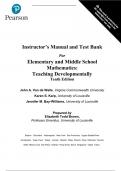Exam (elaborations)
Elementary and Middle School Mathematics Teaching Developmentally 10th Edition by John A. Van de Walle
- Course
- Institution
SECTION I: Teaching Mathematics: Foundations and Perspectives Teaching Mathematics in the 21st Century Exploring What It Means to Know and Do Mathematics Teaching through Problem Solving Planning in the Problem-Based Classroom Creating Assessments for Learning Teaching Mathematics Equitably t...
[Show more]



